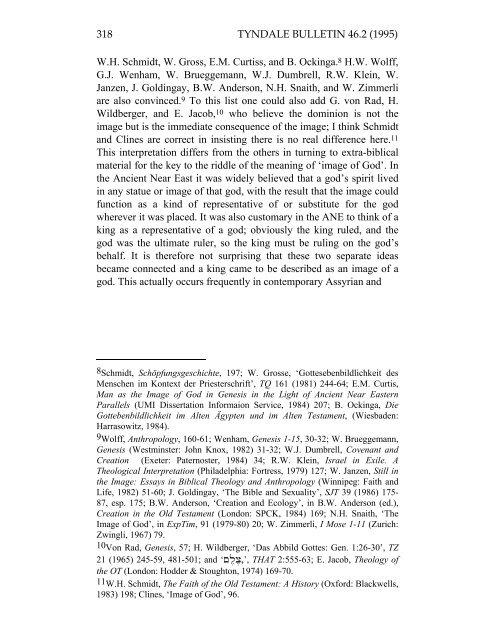GENESIS 1:1-2:3 AS A PROLOGUE TO THE BOOK ... - Tyndale House
GENESIS 1:1-2:3 AS A PROLOGUE TO THE BOOK ... - Tyndale House
GENESIS 1:1-2:3 AS A PROLOGUE TO THE BOOK ... - Tyndale House
Create successful ePaper yourself
Turn your PDF publications into a flip-book with our unique Google optimized e-Paper software.
318 TYNDALE BULLETIN 46.2 (1995)<br />
W.H. Schmidt, W. Gross, E.M. Curtiss, and B. Ockinga. 8 H.W. Wolff,<br />
G.J. Wenham, W. Brueggemann, W.J. Dumbrell, R.W. Klein, W.<br />
Janzen, J. Goldingay, B.W. Anderson, N.H. Snaith, and W. Zimmerli<br />
are also convinced. 9 To this list one could also add G. von Rad, H.<br />
Wildberger, and E. Jacob, 10 who believe the dominion is not the<br />
image but is the immediate consequence of the image; I think Schmidt<br />
and Clines are correct in insisting there is no real difference here. 11<br />
This interpretation differs from the others in turning to extra-biblical<br />
material for the key to the riddle of the meaning of ‘image of God’. In<br />
the Ancient Near East it was widely believed that a god’s spirit lived<br />
in any statue or image of that god, with the result that the image could<br />
function as a kind of representative of or substitute for the god<br />
wherever it was placed. It was also customary in the ANE to think of a<br />
king as a representative of a god; obviously the king ruled, and the<br />
god was the ultimate ruler, so the king must be ruling on the god’s<br />
behalf. It is therefore not surprising that these two separate ideas<br />
became connected and a king came to be described as an image of a<br />
god. This actually occurs frequently in contemporary Assyrian and<br />
8Schmidt, Schöpfungsgeschichte, 197; W. Grosse, ‘Gottesebenbildlichkeit des<br />
Menschen im Kontext der Priesterschrift’, TQ 161 (1981) 244-64; E.M. Curtis,<br />
Man as the Image of God in Genesis in the Light of Ancient Near Eastern<br />
Parallels (UMI Dissertation Informaion Service, 1984) 207; B. Ockinga, Die<br />
Gottebenbildlichkeit im Alten Ägypten und im Alten Testament, (Wiesbaden:<br />
Harrasowitz, 1984).<br />
9Wolff, Anthropology, 160-61; Wenham, Genesis 1-15, 30-32; W. Brueggemann,<br />
Genesis (Westminster: John Knox, 1982) 31-32; W.J. Dumbrell, Covenant and<br />
Creation (Exeter: Paternoster, 1984) 34; R.W. Klein, Israel in Exile. A<br />
Theological Interpretation (Philadelphia: Fortress, 1979) 127; W. Janzen, Still in<br />
the Image: Essays in Biblical Theology and Anthropology (Winnipeg: Faith and<br />
Life, 1982) 51-60; J. Goldingay, ‘The Bible and Sexuality’, SJT 39 (1986) 175-<br />
87, esp. 175; B.W. Anderson, ‘Creation and Ecology’, in B.W. Anderson (ed.),<br />
Creation in the Old Testament (London: SPCK, 1984) 169; N.H. Snaith, ‘The<br />
Image of God’, in ExpTim, 91 (1979-80) 20; W. Zimmerli, I Mose 1-11 (Zurich:<br />
Zwingli, 1967) 79.<br />
10Von Rad, Genesis, 57; H. Wildberger, ‘Das Abbild Gottes: Gen. 1:26-30’, TZ<br />
21 (1965) 245-59, 481-501; and ‘םֶלֶצ,’, THAT 2:555-63; E. Jacob, Theology of<br />
the OT (London: Hodder & Stoughton, 1974) 169-70.<br />
11W.H. Schmidt, The Faith of the Old Testament: A History (Oxford: Blackwells,<br />
1983) 198; Clines, ‘Image of God’, 96.

















